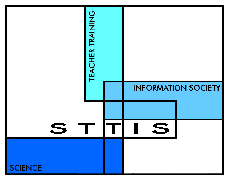Workshop 1
 Contents Contents
|
Section
B Learning about the innovation
Activity
B5 Iteration |
|
Aims
-
To learn how a spreadsheet
can be used to model situations
that evolve over time through iteration.
-
To consider the usefulness
of these models in teaching
and learning.
Background
The models in this activity
are iterative models.
They are concerned with processes that evolve over time, and when these
models are run, each variable is successively calculated from the
values
of the variables in the preceding time interval. The advantage of this
numerical technique is that it makes it easier to construct models of
situations
that would be difficult, or even impossible, to represent analytically.
| For this activity you will need
to open two spreadsheet workbooks. There are notes on each model -
point
to the first cell to display the comment. |
Force and motion

Download ‘models5a'
|
Electricity

Download ‘models5b'
|
What to do
1. Model 5a.1 (page
2) shows the behaviour of an object falling in air. Before
looking
at the model, it would be useful to read the notes that accompany it.
Explore
the effects on the shape of the graph of changing the initial velocity,
the mass, the drag factor and the acceleration due to gravity.
It is also
interesting to explore the effects
of changing the value of the time interval of the iteration. This leads
to effects that are related to the method of calculation rather than to
the actual behaviour of the physical system.
2. Model
5b.1 (page
3) shows the exponential decay of a capacitor discharging.
Before looking
at the model, it would be useful to read the notes that accompany it.
Explore
the effects on the shape of the graph of changing the capacitance, the
potential and the resistance. Again it is interesting to explore the
effects
of changing the value of the time interval.
3. Do you
think that these models are useful
in the classroom? How would you integrate these activities into your
existing
teaching? Would you use these models before you did practical work,
after
you did practical work or instead of practical work? Can you think of
any
improvements that you would like to make to these models?
4. If you
are competent in using a spreadsheet,
then you could try to see how these iterative models have been
constructed
and to attempt to create one yourself. Do you think it would be useful
for pupils to construct these kinds of model? Would it be useful for
them
to copy a model that had already been constructed? Or would you expect
them to be able to contribute to the design of the model themselves?
|

 Teaching with computer models
Teaching with computer models

